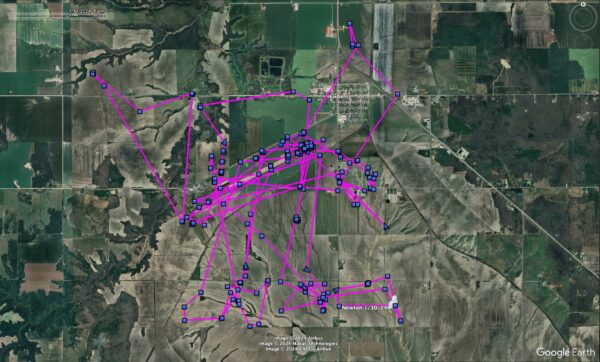
Hochelaga, as in past winters, is moving constantly over a wide area near Montréal. (©Project SNOWstorm and Google Earth)
So far this winter, two of our previously tagged snowy owls have come far enough south to register on the cell network and send data — Newton, an adult male tagged last winter in southern Ontario, and Hochelaga, another male that is at least 10 years old, who came down into southern Québec after remaining in the subarctic last winter.
They’ve been showing very different movement patterns since checking in regularly every Sunday, Tuesday and Thursday evening (the transmission cycle we’ve set for their transmitters). Newton, who has stuck tight to the farmland northwest of Lake Timiskaming on the Ontario/Québec border, has been using a daily activity area roughly 5 km square, and which as we’ve noted before includes a small, lightly used rural airport.
Hochelaga, on the other hand, has been moving very widely around the area of southern Québec near Montréal — sometimes hanging out at Montréal-Trudeau International Airport (which is where he was originally trapped and banded in 2016, and retrapped and tagged in early 2021), as well as the neighboring highways, but he’s flown as much as 53 km (33 miles) west to the farmland lying between the St. Lawrence and Ottawa rivers, and at other times 24.5 km (15 miles) south across the St. Lawrence to agricultural land near Châteauguay, QC.

Newton, in keeping with his past behavior, is staying in one small area. (©Project SNOWstorm and Google Earth)
Why such a big difference in their movement patterns? There could be a number of reasons. Food might be an obvious reason; perhaps Newton struck it rich with a lot of easy prey, while Hochelaga hasn’t found a honey-hole yet.
But we used the word “personality” in the headline, and the more we study snowy owls, the more I find myself wondering if their movement patterns aren’t a reflection of what we would in any other creature all its personality type. With both of these owls we have a couple years’ worth of data to compare — Hochelaga in the winters of 2020-21 and 2021-22, and Newtown from last winter.
In both cases, we see owls acting similarly, each to their own and year to year. Newtown was a stay-at-home bird for a lot of last winter, using a very small area in southern Ontario near the town of Listowel. He did make a big circuit of that region the last half of February, but that’s a time by which a lot of adult snowies, especially males that have to get north to prospect for areas in which to potentially breed, get restless, and not long after he headed north for good.
Hochelaga, on the other hand, spent the two previous winters doing just what’s he’s doing this year, moving widely in almost exactly the same areas he’s using this season. I find it hard to believe that for three out of the past four years he’s having a hard time finding places with good prey — I think he’s just an owl that has wandering feet, much as Newton seems to be an owl that plunks himself down and stays put.
Once, the idea of “personalities” in animals was considered heretical by many scientists, but as researchers have looked with less jaundiced, prejudiced eyes, they’re seen what anyone who has cared for a pet knows — of course animals have their own personalities. Our tracking data may be a window into that aspect of a snowy owl’s interior life, too.


4 Comments on “Two Owls, Two Personalities”
We are wondering why we havent seen any snowy owls this year in eastern upper peninsula this year 2024.
It’s not just the U.P., Sandy — this is the slowest winter for snowy owls in the Great Lakes and Northeast since 2010-11. There appears to have been little or no breeding activity in the eastern and central Canadian Arctic last summer, which is not unusual if there is a widespread, coincidental low point in regional lemming populations. Big flight years, after all, are dominated by young owls. We also suspect the relatively mild winter thus far in many places has kept some owls farther north than usual, because our two returning tagged snowies didn’t come south until the first real significant blast of cold weather last month. That said, as we’ve discussed in our blog previously, we are concerned that we might be seeing at least some effect from highly pathogenic avian influenza on snowy owl numbers. We’ll just have to wait and see.
Another snowy owl (male) was seen not far from were Hochelaga made a visit.
https://ebird.org/checklist/S160218646
In mid January of 2017 I saw a adult male snow owl that was
hunting near the highway 40 in Montréal.
I was able to take pictures an video of the owl in action
and it might show what Hochelaga did when he visited
the same location this year.
Pictures:
https://photos.app.goo.gl/XY8KYmWZ5XF9XyXd9
Video:
https://youtu.be/fEpyMvBdQNA